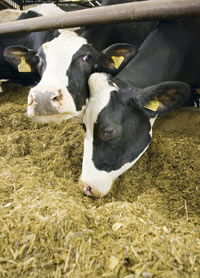Good nutrition keeps cows healthy and productive

Optimising the rumen environment for fibre degrading micro-organisms is key to dairy cow productivity and longevity, according to Biotal’s Johnny Bax speaking at a recent open day.
“You have got to keep the rumen bugs healthy as they are what process the forage, and good quality forage is the cornerstone of good health and longevity,” he said. These bacteria, fungi and protozoa thrive in a high pH rumen, but are destroyed by acidic conditions, often created by feeding concentrates or poor quality silage.
At a pH of 6.4, the micro-organisms digest almost 54% of fibre, while at 5.6 pH this falls to just 34% – equivalent to a daily drop of 2.5 litres of milk, said Mr Bax. Acid conditions also destroy rumen papillae, vital for absorption of nutrients. In mild cases of acidosis these can recover slowly, but in severe cases will be burned off permanently. “We therefore have to be careful how we treat animals in the transition from one diet to another.”
As well as managing changes in diet, farmers should ensure long forage chop lengths to encourage beneficial cudding. “Always choose palatability over D value – when you haven’t got a healthy rumen you will not have healthy cows.”
Choosing correct silage inoculants and managing silos carefully is also essential to avoid crop spoilage. In addition, feeding rumen-specific probiotics can guard against acidosis, as well as improving fibre utilisation, particularly where forage quality is lower, he added.
Markus Hohl, who hosted the event at Barton Close Farm, near Barnstaple, reckoned a mixture of forages was the key to palatability. He uses white clover and ryegrass in grazing pastures, with red clover and Italian ryegrass for silage leys. He also grows winter triticale to crimp for protein, forage beet for energy, and spring barley/pea and lupin/triticale mixes for palatable, balanced forage.
Mr Hohl layers the different crops through the silage clamp, which he covers with an oxygen barrier film to reduce top and shoulder wastage and to improve fermentation.
“The high yielders are fed the centre of the clamp, and the low yielders get the sides.” All cows are buffer fed throughout the summer to slow down their consumption of clover, with high yielders also fed a concentrate blend in the parlour. “But we want to make the most of grazing, so it’s trying to find a balance.”
Using a mixer wagon, he aims for a long chop length and fluffy ration to improve palatability and reduce sorting by the cows. He feeds one ration to the high yielders and one to the lows, with transition cows receiving a portion of the milking ration plus ad-lib haylage. “I don’t want to change the ration too often, because when the cows are well and the rumen is fine, I don’t want to upset them.”
Having converted to organic 12 years ago, Mr Hohl started cross-breeding his pedigree Holstein cows with Swedish Red and Dairy Shorthorns and has recently incorporated Scandinavian Red and Fleckvieh genetics. “My main objective is to produce profitable milk from cows that are healthy, fertile, high yielding, and are able to continue in production as such for many lactations.”
As a result of this breeding and careful feeding regime, the cows are averaging 5.5 lactations, with a 305 day yield to the end of August of 8000 litres, with 4800 litres from forage.
